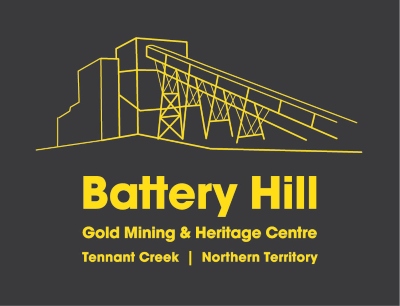History of Battery Hill & The Barkly Region
TENNANT CREEK
Tennant Creek was a source of reliable water for the local aboriginals.
The Creek was named after John McDouall Stuart’s associate John Tennant.
Known as the ‘seven-mile policy’ of the Overland Telegraph Line, no settlement could be located any closer than 7 miles from any Telegraph station.
The town is 900 kilometres South of Darwin and 510 kilometres north of Alice Springs.
Tennant Creek was the first place in the world where gold had been found in ironstone.
In 1934 the famous ‘goldrush’ or land claim took place. A pistol was fired into the air and approximately 20 men armed with leases or ‘rights’ dashed to their chosen spot and pegged.
NOBLES NOB
Originally claimed in 1933 and located 16 kilometres east of Tennant Creek, Nobles Nob was discovered by two men Jack Noble (with sight in one eye only) and Billy Weaber (completely blind).
Noble would find a likely gold looking specimen, and describe it minutely to Weaver, who would handle it for some time, ‘seeing’ with his fingers.
The two men would discuss it, pool their conclusions and decide yes or no.
By the end of 1985, it was considered worked out. Its total production of gold was over 32 tons.
RISING SUN
Pegged by Noble and Weaber.
At the time of establishment, it was the most easterly mine – approximately 6 miles southeast of Tennant Creek.
1935 – 19,640 ounces of gold.
PEKO
Established in early 1934 by a Polish man by the name of Joe Kaczensky and Bill Bohning whose family resided in Katherine.
Peko is located 8 kilometres east of Tennant Creek. The mine was named after his dog Peko.
In 1974 Peko built a flash smelter, employed 800 staff and paid out $6 million per annum in wages.
The total production of the mine was 235,849 ounces of gold and 1,419,907 ounces of silver
NORTHERN STAR
First mentioned in 1934 it was named northern star because at the time of being pegged it was the most northerly mine.
In 1935 to 36 the mine produced 486.7 ounces of gold to the value of £4006.
In 1939 to 1940 a total of eight men were employed to work the mine.
With the advent of new mining techniques and advanced equipment, this site was revisited at a later date.
WARREGO
The Warrego mine, located 50 kilometres northwest of Tennant Creek, is the fifth mine of the Normandy Mining Group – including Orlando, Peko and Gecko.
Surface drilling took place in September of 1959. A five-year programme of construction and development was begun in July 1966. Full production commenced in 1971.
Warrego became a fully-fledged town with construction of a bitumin road and a power line connecting into the Peko power station, a rural carrier telegraph phone line with internal PABX system and three fresh water dams through a permanent purification plant.
A fully equiped workshop and warehouse were built along with administration block and other relevant amenities. At its peak Warrego boasted a population close to 5000 people with the reputed largest caravan park in the southern hemisphere.
The headframe, erected in July 1968, and three shafts were operational by the mid-70s producing copper and gold. Warrego is noted for having provided 95% of Australia’s bismuth (a brittle metallic element using used in alloys).
The Township had gazetted streets with lighting and signage, a public pool, Lions Ppark, Oval, tennis and basketball courts, a fully air-conditioning social club, general store, library, bank, betting hall and primary school.
Warrego Township was closed and evacuated by the end of 1999, with the final removal of non-brick homes as late as 2003. The primary school is still functioning and is run by the NT education department.
The mining lease has changed hands and still operates out of the original site. Fencing has been erected around the production area with the Township precinct is in the process of being taken back to its natural state.
Phone: 08 8962 1281
Email: batteryhill@discoverca.com.au



